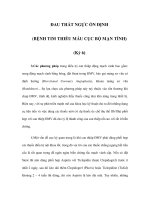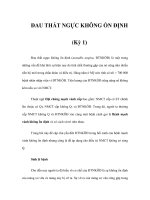ĐAU THẮT NGỰC KHÔNG ỔN ĐỊNH (Kỳ 5) potx
Bạn đang xem bản rút gọn của tài liệu. Xem và tải ngay bản đầy đủ của tài liệu tại đây (280.69 KB, 8 trang )
ĐAU THẮT NGỰC KHÔNG ỔN ĐỊNH
(Kỳ 5)
Điều trị can thiệp ĐMV (nong hoặc đặt Stent)
Chỉ định cho chụp ĐMV: để can thiệp ĐMV đã được bàn đến ở phần chỉ
định chụp ĐMV nói trên.
Các tổn thương ĐMV phù hợp cho can thiệp là: tổn thương ngắn, không
vôi hoá, tổn thương ít mạch, không phải thân chung, chức năng thất trái còn tốt
Một số trung tâm có điều kiện trang thiết bị và kinh nghiệm tốt của bác sỹ
can thiệp thì có thể xét can thiệp ngay (cấp cứu) cho mọi bệnh nhân ĐTNKÔĐ khi
đến viện, tuy nhiên kết quả chưa vượt trội so với bắt đầu bằng điều trị nội khoa.
Hình 1-2. Hình ảnh ĐTĐ của một trường hợp ĐTNKÔĐ, ST chênh xuống
và T âm từ V1-V6
Khi can thiệp ĐMV, việc dùng phối hợp các thuốc là rất quan trọng:
Các thuốc chống ngưng kết tiểu cầu đường uống : Aspirin phối hợp với
Ticlopidin hoặc Clopidogrel.
Thuốc ức chế thụ thể Glycoprotein IIb/IIIa.
Thuốc chống đông (Heparin, LMWH).
Hình 1-3. Hình ảnh chụp động mạch vành của bệnh nhân ĐTNKÔĐ trước
(hình trái) và sau (hình phải) đặt Stent (mũi tên chỉ vị trí thương tổn).
Mổ làm cầu nối chủ-vành
Các chỉ định cho phẫu thuật:
Tổn thương nhiều thân ĐMV mà đoạn xa còn tốt.
Tổn thương thân chung ĐMV.
Các tổn thương quá phức tạp (vôi hoá, xoắn vặn, gập góc, chỗ chia
nhánh ) mà không thể can thiệp nong hoặc đặt stent được.
Thất bại khi can thiệp.
Các yếu tố dự đoán nguy cơ cao cho phẫu thuật là: tuổi cao, có nhiều bệnh
nặng kèm theo, chức năng thất trái giảm nhiều, tiểu đường, kinh nghiệm của phẫu
thuật viên Tuy nhiên, một số nghiên cứu (BARI, CASS) cho thấy ở những bệnh
nhân tiểu đường hoặc suy giảm chức năng thất trái, có tổn thương nhiều thân
ĐMV thì phẫu thuật làm cầu nối tỏ ra ưu thế hơn so với can thiệp ĐMV.
Thực hành BỆNH TIM MẠCH NGUYỄN LÂN VIỆT (Chủ biên)
Tài liệu tham khảo
Antman EM, Tanasuevic MJ, Thompson B, et al. Cardiac-specific troponin
I levels to predict the risk of mortality in patients with acute coronary syndromes.
N Engl J Med 1996;335:1342-1349.
Bittl JA, Strony J, Brinker JA, et al. Treatment with bivalirudin (Hirulog) as
compared with heparin during coronary angioplasty for unstable or ostinfarction
angina. N Engl J Med 1995;333:764-769.
Boden WE, O'Rourke RA, Crawford MR, et al. Outcomes in patients with
acute non-Q-wave myocardial infarction randomly assigned to an invasive as
compared with a conservative management strategy. N Engl J Med
1998;338:1785-1792.
Braunwald EG, Mark DB, Jones RH et. al. Unstable angina: diagnosis and
management. Clinical Practice Guideline Number 10. AHCPR Publication No.94-
0602. Rockville, MD: Agency for Health Care Policy Research and the National
Heart, Lung, and Blood Institute, Public Health Service, U.S. Department of
Health and Human Services, 1994.
Cohen M, Demers C, Garfinkel EP, et al. Low-molecular-weight heparins
in non-ST segment elevation ischemia: the ESSENCE trial. Am J Cardiol
1998;82:196-246.
EPILOG Investigators. Platelet glycoprotein Ilb/lIla receptor blockade and
low-dose heparin during percutaneous coronary revascularization. N Engl J Med
1997; 336:1689-1696.
Fuster V, Badimon L, Badimon JJ, et. al. The pathogenesis of coronary
artery disease and the acute coronary syndromes. N EngI J Med 1992;326:242-
250.
Gersh BJ, Braunwald EG, Rutherford JD. Chronic coronary artery disease:
unstable angina. In: Braunwald EG, ed. Heart disease: a textbook of
cardiovascular medicine, 5th ed. Philadelphia: WB Saunders, 1997:1331-1339.
Granger CB, Califf RM. Stabilizing the unstable artery. In: Califf RM,
Mark DB, Wagner GS, eds. Acute coronary care, 2nd ed. St. Louis: Mosby,
1995:525-541.
Hamm CW, Goldmann BU, Heeschen C,et al. Emergency room triage of
patients with acute chest pain by means of rapid testing for cardiac troponin T or I.
N Engl J Med 1997;337:1648-1653.
Lincoff AM, Califf RM, Moliterno DM, et al. Complementary clinical
benefits of coronary-artery stenting and blockade of platelet glycoprotein lIb/Illa
receptors. N Engl J Med 1999;341:319-327.
Moliterno DJ, Granger CB. Differences between unstable angina and acute
myocardial infarction: the pathophysiological and clinical spectrum. In: Topol EJ,
ed. Acute coronary syndromes, 1st ed. New York: Marcel Dekker, 1998:67-104.
Ohman EM, Armstrong PW, Christenson RH, et al. Cardiac troponin T
levels for risk stratification in acute myocardial ischemia. N Engl J Med
1996;335:1333-1341.
Oler A, Whooley MA, Oler J, et al. Adding heparin to aspirin reduces the
incidence of myocardial infarction and death in patients with unstable angina: a
meta-analysis. JAMA 1996;276:811-515.
Roe MT. Unstable angina and non-ST-segment elevation MI. In: Marso SP,
Griffin BP, Topol EJ, eds. Manual of Cardiovascular Medicine. Philadelphia:
LippincottRaven, 2000.
Stone PH, Thompson B, Anderson HV, et al. Influence of race, sex, and
age on management of unstable angina and non-Q-wave myocardial infarction: the
TIMI III registry. JAMA 1996;275:1104-1112.
Theroux P, Ouimet H, IvicCans J, et. al. Aspirin, heparin, or both to treat
acute UA. N Engl J Med 1988;319:1105-1111.
TIMI IIIB Investigators. Effects of tissue plasminogen activator and a
comparison of early invasive and conservative strategies in unstable angina and
non-Q-wave myocardial infarction. Circulation 1994;89: 1545-1556.
Van Miltenburg AJ, Simoons ML, Veerhoek RJ, et al. Incidence and
follow-up of Braunwald subgroups in unstable angina. J Am Coll Cardiol
1995;25:1256A292.
White RD. Unstable angina: ischemic syndromes. In: Topol EJ, ed.
Textbook of cardiovascular medicine. 1st ed. Philadelphia: Lippincott-Raven,
1998:365-393.
Williams DO, Braunwald E, Thompson B, et al. Results of percutaneous
transluminal coronary angioplasty in unstable angina and non-Q-wave myocardial
infarction: observations from the TIMI IIIB trial. Circulation 1996;94:2749-2755.









